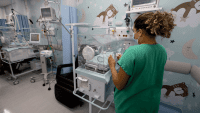My organization’s journey to Magnet™ recognition shifted into high gear after we received a score of “excellent” on the application document we submitted to the American Nurses Credentialing Center (ANCC). This document provided evidence that the 14 Forces of Magnetism (since streamlined into 5 Model Components) were “alive and well” throughout our nursing practice and work environment. Next step: the site visit by Magnet appraisers.
The visit was to take place a few months later, but we started to prepare for it immediately. The visit would serve as an opportunity for us to showcase our nurses’ ability to practice the art and science of nursing in a way that achieves patient and nurse satisfaction, high-quality care, positive patient outcomes, and an environment that employees describe as a great place to work.
As a Magnet coordinator and creator of the application document sent to ANCC, I knew my organization would need to paint an accurate picture of what the appraisers would see and experience. The visit would serve as an opportunity to clarify and amplify information in the document while enabling the appraisers to verify the information.
What to expect
Once a site visit is scheduled, the lead Magnet appraiser and the hospital’s Magnet coordinator set a tentative schedule for the visit, and the coordinator provides a list of focus groups that the appraisal team will meet with. Staff members chosen to participate in focus groups should be familiar with—and able to intelligently discuss—the structures and processes defined in the written document. Examples of focus-group participants may include the organization’s executive leaders; nurse executive leaders; advanced practice nurse council members; nurse practice council members; managers’ council members; nurse education team; nursing researchers; members of the policy and procedure committee and the ethics committee; and members of the Quality of Care Performance Improvement team.
Preparing for the visit
We found that careful planning and preparation go a long way toward smoothing bumps on the road to Magnet recognition. One of our priorities was to make our nurses comfortable stepping forward to talk to Magnet appraisers and to answer their questions without hesitation. To prepare them, we asked them to think about how they’d respond to these questions:
- What types of patients do you care for?
- Why should these patients come to this facility?
- What’s the work environment like here?
- What’s the best thing about being a nurse here?
- What’s your least favorite thing about working here? (No one’s perfect!)
- What keeps you here?
- What are you most proud of on your unit? How does this attribute promote the success of your organization’s mission to provide quality health care to everyone it serves?
- What would Magnet recognition mean to you?
- Why do you think you are a Magnet nurse?
In addition, Magnet “champions” in our organization created flashcards based on these and other questions. Nonclinical staff members aided in preparation for the visit; using the flashcards as springboards to conversation, they asked the nurses to share their answers to questions written on the flashcards. This “rehearsal” made the nurses more comfortable speaking about their practice, while giving nonclinical staff an opportunity to learn more about the nursing profession.
In the meantime, nurse leaders helped prepare our focus-group members. We met with them several times before the site visit, helping them determine the most important points to convey to the Magnet appraisers. Participants volunteered to make sure these points were communicated during the interview process. We knew time would be limited, so we emphasized the importance of collecting one’s thoughts and using the interview time as effectively as possible.
Mock site visit
As part of our preparation, we conducted a mock site visit. Our mock appraiser stepped off an elevator, stopped an Environmental Services employee, and asked her about her relationship with staff nurses. The employee burst into tears! Once she was composed enough to answer, she told the “appraiser” that “the nurses in the Women and Children’s Department are my family.” That powerful statement reflects the quality of the relationships nurtured at our organization. During the real site visit, we found many employees (both nurses and others) who were willing to speak about the positive relationships that exist here among nurses, other departments, and individuals here.
A strong showing
When the site visit finally happened, Magnet appraisers found a culture where concern for the patient is paramount, strong nursing and organizational leadership is evident, nurses demonstrate autonomy, collaborative relationships abound, support for professional development is unwavering, and ongoing interdisciplinary performance improvement initiatives are apparent.
On patient care units, appraisers interviewed staff members and spoke with patients and families. This gave nurses a chance to tell the appraisers what they’re doing well. Nurses pointed out that their units had been highlighted in the Magnet application document, and amplified the vital difference they believed they were making in their nursing practice.
On their visit, the Magnet appraisers were able to validate the claims we’d made about our organization. Their conversations with nurses, ancillary department employees, physicians, volunteers, and others gave them insight into the professional interdisciplinary relationships that have been fostered throughout our organization. They observed professionalism, pride in practice, knowledge, and skill by the many nurses who took part in the rigorous 2-day visit.
The reward of Magnet recognition
Our preparation paid off—we were awarded Magnet recognition. In their executive summary, Magnet appraisers wrote that our organization “has fostered a culture that includes a commitment to excellence; patient and family centered care; strong work ethic; commitment to the community; open communication with a true ‘open door’ policy and practice; respect for each other, and an environment that encourages and supports employee involvement in planning, problem solving, and decision-making.”
Lessons for other facilities
If your facility is seeking Magnet recognition, prepare your staff for the site visit by educating them about what to expect. This will help take the fear out of the unknown. (See Navigating the Magnet™ recognition journey below.)
Navigating the Magnet™ recognition journey
Here are some tips for healthcare organizations about to embark on the Magnet™ journey.
- Appoint a Magnet coordinator. Ideally, your organization should have a Magnet coordinator who oversees arrangements, such as appointing hosts for the site visit, fine-tuning the schedule, selecting meals, and arranging transportation, materials, equipment, and meeting spaces.
- Devise a navigation strategy. Current Magnet organizations are expected to mentor others in their journey of excellence, so start by contacting staff members at these organizations and ask for advice. For an updated listing, visit www.nursecredentialing.org/MagnetOrg/getall.cfm. Network with the contacts you make, and heed the lessons they’ve learned.
- Put together your own “itinerary” for your Magnet journey by developing an action plan that will make the experience fun and enjoyable for your staff. Our Magnet champions prepared themselves to lead the journey by attending and graduating from a “Magnet Boot Camp.” They generated excitement by planning “tours” for employees, a Magnet Fair, poster presentations, computer-based learning, bulletin boards, Magnet binders, Magnet Travel Cart, Q & A fact sheets, a logo contest, mock site visits, and more. Magnet champions took every opportunity to share the importance of enjoying the journey, rather than focusing solely on the destination (Magnet recognition).
- Map it! Provide a “map” of your site visit to everyone involved. Take away the guessing so everyone involved knows where they should be, and when, as well as what the expectations are. Clear, concise directions help ensure a site visit that’s worry-free, relaxing, and enjoyable.
Our preparation gave us the opportunity to build new relationships and strengthen old ones at every level. We were able to create a sense of community and help staff develop a deeper appreciation for each other as individuals and contributors of quality care, as well as to appreciate the partnership and equity we have as members of our organization. On our Magnet journey, we grew, explored, and had fun as an organization—and ultimately celebrated our accomplishment of attaining Magnet recognition.
Rebecca Floyd is the Magnet Coordinator at Schneck Medical Center in Seymour, Indiana.


















1 Comment.
Can you share what types of questions the appraisers might ask a patient?